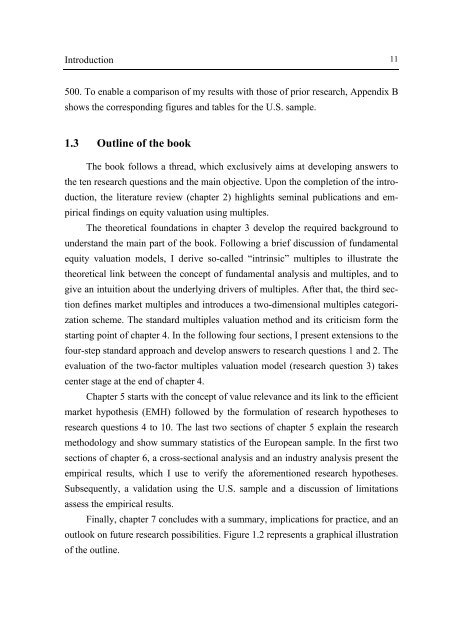Equity Valuation Using Multiples: An Empirical Investigation
Equity Valuation Using Multiples: An Empirical Investigation
Equity Valuation Using Multiples: An Empirical Investigation
Create successful ePaper yourself
Turn your PDF publications into a flip-book with our unique Google optimized e-Paper software.
Introduction 11500. To enable a comparison of my results with those of prior research, Appendix Bshows the corresponding figures and tables for the U.S. sample.1.3 Outline of the bookThe book follows a thread, which exclusively aims at developing answers tothe ten research questions and the main objective. Upon the completion of the introduction,the literature review (chapter 2) highlights seminal publications and empiricalfindings on equity valuation using multiples.The theoretical foundations in chapter 3 develop the required background tounderstand the main part of the book. Following a brief discussion of fundamentalequity valuation models, I derive so-called “intrinsic” multiples to illustrate thetheoretical link between the concept of fundamental analysis and multiples, and togive an intuition about the underlying drivers of multiples. After that, the third sectiondefines market multiples and introduces a two-dimensional multiples categorizationscheme. The standard multiples valuation method and its criticism form thestarting point of chapter 4. In the following four sections, I present extensions to thefour-step standard approach and develop answers to research questions 1 and 2. Theevaluation of the two-factor multiples valuation model (research question 3) takescenter stage at the end of chapter 4.Chapter 5 starts with the concept of value relevance and its link to the efficientmarket hypothesis (EMH) followed by the formulation of research hypotheses toresearch questions 4 to 10. The last two sections of chapter 5 explain the researchmethodology and show summary statistics of the European sample. In the first twosections of chapter 6, a cross-sectional analysis and an industry analysis present theempirical results, which I use to verify the aforementioned research hypotheses.Subsequently, a validation using the U.S. sample and a discussion of limitationsassess the empirical results.Finally, chapter 7 concludes with a summary, implications for practice, and anoutlook on future research possibilities. Figure 1.2 represents a graphical illustrationof the outline.
















